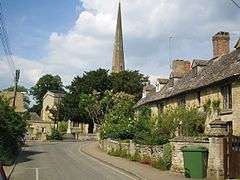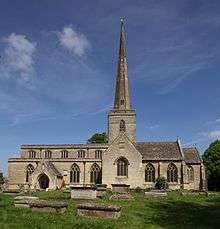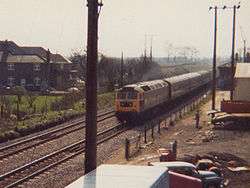Kidlington
| Kidlington | |
|---|---|
 Church Street, Kidlington | |
 Kidlington Kidlington shown within Oxfordshire | |
| Population | 13,723 (2011 Census) |
| OS grid reference | SP4914 |
| Civil parish |
|
| District | |
| Shire county | |
| Region | |
| Country | England |
| Sovereign state | United Kingdom |
| Post town | Kidlington |
| Postcode district | OX5 |
| Dialling code | 01865 |
| Police | Thames Valley |
| Fire | Oxfordshire |
| Ambulance | South Central |
| EU Parliament | South East England |
| UK Parliament | |
| Website | Kidlington Parish Council |
Kidlington is a large village and civil parish between the River Cherwell and the Oxford Canal, 5 miles (8 km) north of Oxford and 7 1⁄2 miles (12 km) southwest of Bicester. The 2011 Census recorded the parish's population as 13,723.[1]
History
Kidlington's toponym is derived from the Old English Cudelinga tun: the tun (settlement) of the "Kidlings" (sons) of Cydel-hence. The Domesday Book in 1086 records Chedelintone, and by 1214 the spelling Kedelinton appears in a Calendar of Bodleian Charters.
The Church of England parish church of St Mary the Virgin dates from 1220 but there is evidence of a church on the site since AD 1073. St Mary's has fine medieval stained glass and a 220-foot (67 m) spire known as "Our Lady's Needle". It is a Grade I listed building.[2]
The tower has a ring of eight bells. Richard III Chandler of Drayton Parslow in Buckinghamshire cast the seventh bell in 1700. Abraham I Rudhall of Gloucester cast the tenor bell in 1708 and the fifth bell in 1715. Mears and Stainbank of the Whitechapel Bell Foundry cast the treble, second, third, fourth and sixth bells in 1897,[3] the year of Queen Victoria's Diamond Jubilee.
Behind the church there are archaeological remains of a three-sided moat, and a causeway has recently been discovered which may be of Roman origin. St Mary's Rectory is Tudor.
Beside the church are the almshouses, built by Sir William Morton in 1671 in memory of his wife and children, whose names are inscribed above the windows. Sir William was a Royalist Commander during the Civil War and lived in nearby Hampden Manor in Mill Street. Other famous residents of Hampden Manor include Sir John Vanbrugh who lived here during the building of Blenheim Palace in Woodstock. The square tower water closet in the front garden of Hampden Manor was built by Vanbrugh. It drains into a brook that now runs underground along Mill Street into the nearby River Cherwell. Thomas Beecham formulated his medicine whilst living in a cottage near the manor, where he worked for a time as a gardener for John Sydenham.

The settlement listed in Domesday grew from an ancient village close to the church. Here there are as many 18th century Georgian buildings as modern houses. Until the Enclosure acts in 1818, a large section south of the village was unenclosed common land, and the village was widely known as Kidlington-on-the-Green. Just prior to the Second World War, this land was built up in an estate known as Garden City.
In the 1920s and 1930s, Kidlington was subject to ribbon development along the main (now A4260) road through the village. Since 1945 many housing estates have been built behind this on both sides.
Oxford Zoo was once located in Kidlington where the Thames Valley Police headquarters now stands. This short-lived attraction was in existence from 1931 until 1937, when the animals were transferred to Dudley Zoo. In 2018, an elephant sculture was installed on a roundabout at the southern end of Kidlington to commemorate the zoo and an elephant that lived there.[4]
In the 20th century, Kidlington grew to be a contender for largest village in England (as well as Europe) with a population of 13,723[1] (compared with 1,300 in 1901). Kidlington residents have so far resisted proposals to become a town, though it clearly qualifies for such status against any criteria. Following a peremptory change by the Parish Council to Town status, the change was voted down in a ballot of the local electorate by 98%, and reversed.
In June 2016, the BBC reported weekly coachloads of sightseers from China arriving on Benmead Road, Kidlington, who were seen posing for photos in front gardens and against parked cars, with no apparent reason for their interest.[5][6] The story attracted worldwide interest with Kidlington locals offering interviews about their experience.[6] In November 2016, after analysing results of a Chinese-language questionnaire given to some of the tourists, the BBC found that "looking for the true sense" of Britain was one reason for the visits.[7]
An investigative journalist determined that, in fact, Chinese tour operators charge $68 extra for Chinese language tours of nearby Blenheim Palace. Tourists who do not want to pay to visit Blenheim are dropped off in Kidlington, which they find charming, but which tour operators select because it is too far from Blenheim to enable tourists to walk to the Palace and pay the cheaper £25 price for public tours in English.[8]
Railways

A railway station on the Oxford and Rugby Railway near Langford Lane was designed by Isambard Kingdom Brunel and opened in 1852. The station was named Woodstock Road although it was nearly 3 miles (5 km) from Woodstock and less than 1 mile (1.6 km) from Kidlington. The Oxford and Rugby Railway was part of the Great Western Railway, which in 1890 added a branch line to a new Blenheim and Woodstock railway station at Woodstock and renamed Woodstock Road "Kidlington". British Railways closed Kidlington railway station in 1964. The station building remained in 1983.
From the 1980s onwards it has been Oxfordshire County Council policy to have a new station on land between Flatford Place and Thorne Close on Lyne Road. The policy is as yet unfulfilled.
At Water Eaton, 1 1⁄2 miles (2.4 km) south of the centre of Kidlington, there was a railway halt at Oxford Road on the former Varsity Line. The halt was opened by the London and North Western Railway in 1905 and closed by its successor, the London, Midland and Scottish Railway in 1926.
In October 2015 Chiltern Railways and Network Rail opened a new Oxford Parkway railway station near the site of the former Oxford Road Halt. It has trains every 30 minutes to London Marylebone via Bicester Village and High Wycombe in one direction and to Oxford in the other.
Amenities
Kidlington has about 50 shops, banks and building societies, a public library, a large village hall and a weekly market. There are seven public houses, two cafes, and four restaurants. The public houses are concentrated along the main A4260 road through the village. North to south these are: the Highwayman Hotel (originally the Anchor, then the Railway Hotel, then the Wise Alderman, before being renamed again in 2009),[9] the Black Horse, the Black Bull, the Red Lion, as well as the King's Arms in the Moors, and the Six Bells in Mill Street. The Squire Bassett was converted into a Nepalese restaurant and renamed the Gurkha Village in 2012.
There is a secondary school (Gosford Hill) and a handful of primary schools to deal with the expanding population. Recently Gosford Hill School has started a narrowband radio show for its pupils.
Kidlington has a Women's Institute.[10]
Economy
The headquarters of the Oxfordshire Fire and Rescue Service, Thames Valley Police and the county St. John Ambulance are all in Kidlington, as is the UK head office of the European publishing company Elsevier. Oxford Airport, renamed London Oxford Airport in 2009, is also in Kidlington; since 1962 it has had a pilot training school that has trained thousands of pilots for many airlines in more than 40 countries. There are several industrial and business parks and a large motor park in the north of the village.
London Oxford Airport is significant to the village's development. Opposite the airport is the Langford Locks industrial estate and Oxford Motor Park which has showrooms for makes including Honda, Nissan and Toyota. [11] Businesses including Essentra Components, Eurocopter and Guylian Chocolates all have premises in the village.
Campsfield House, an immigration detention centre run for the UK Government, is next to the industrial area near the airport.
Music
Kidlington has had a brass band since 1892, with earlier foundations dating back to at least the 1850s. The current band, Kidlington Concert Brass, was founded by the merger of Kidlington Silver Band and Oxford Concert Brass in 1992. It presents regular local concerts and has competed nationally in the highest grade for many years.
Kidlington Amateur Operatic Society (KAOS) was founded in 1977, and presents concerts of varied choral material in the village several times annually in addition to staging regular productions of musicals.
Sports
Kidlington Football Club was founded in 1909. Its first team plays in the Evo-Stik League South West and its reserve side plays in Uhlsport Hellenic Division One West. Kidlington F.C. also runs an under-18 youth team that plays in the Allied Counties League. All three teams play and are based at Kidlington F.C.'s ground in Yarnton Road. The pitch is floodlit and has spectator terracing and seating for 150 spectators. The 2010–11 season saw Kidlington reach the final of the Oxfordshire Senior Cup for the first time in its history where it was beaten by Oxford United at the Kassam Stadium.[12] Kidlington F.C. previously played at other sites in or just outside the village.[13]
Kidlington Royals Football Club is the only Sunday football team in Kidlington, playing in the Premier Division of the Upper Thames Valley League. It was founded in 2004 and plays its home games at Bletchington Sports Ground (just outside Kidlington). It is regarded as one of the best Sunday League sides in Oxfordshire, being made up of players who play at a high level of Saturday football, including the Blue Square (football conference), Southern League and the Hellenic Premier Division. In April 2012 it reached the final of the Oxfordshire FA Sam Waters Challenge Cup. It lost 3-2 after extra time to Highfield.[14] The club reached the final of this competition again in 2013.
Kidlington Old Boys Football club was formed in 1999, and currently plays in the Oxfordshire Senior League Division 1. It plays its home games at Exeter Close.[15]
The Gosford All Blacks was founded on 15 May 1956, taking its name from the New Zealand All Blacks team which was touring that season. Despite its name, the club is based in Kidlington.[16] Gosford's first team plays in the Berks, Bucks & Oxon Premier League. When first founded, the club used the Gosford Hill School pitch and facilities. The King's Arms, the Moors, became its headquarters. In May 1959 the club moved to Langford Lane and in December 1962 became the youngest club to acquire its own clubhouse. The neighbouring airport donated one of its hangars, which the members transformed into a clubhouse. Gosford All Blacks was county rugby shield holder for the 2011–12 season.
Kidlington Cricket Club was founded in 1837 and used to play in the Oxford Times Cherwell Cricket League.[17] However, in January 2009 the League voted to expel Kidlington CC for alleged rule breaches.[18] As of the 2010 season, the club now plays in the Oxfordshire Cricket Association (OCA) league.
From 1976 until 1998, Kidlington was the home base for motor racing team Tom Walkinshaw Racing, founded by Scottish racing driver Tom Walkinshaw. TWR raced a variety of cars including the Rover Vitesse, Mazda RX-7, Jaguar XJS and Holden Commodore as well as being the factory backed Jaguar team in both Sports car racing and Touring car racing. TWR would win numerous championships including the World Sportscar Championship and both the European and British Touring Car Championships as well as a number of high-profile races including the 24 Hours of Le Mans, the Spa 24 Hours and the Bathurst 1000.[19]
References
- 1 2 "Area: Kidlington (Parish): Key Figures for 2011 Census: Key Statistics". Neighbourhood Statistics. Office for National Statistics. Retrieved 24 September 2013.
- ↑ Historic England. "Church of St Mary (Grade I) (1291046)". National Heritage List for England. Retrieved 14 April 2015.
- ↑ Bull, Andrew (28 January 2008). "Kidlington S Mary V". Dove's Guide for Church Bell Ringers. Central Council for Church Bell Ringers. Retrieved 14 April 2015.
- ↑ "Elephant sculpture commemorates short-lived Oxford Zoo". BBC News. UK: BBC. 4 October 2018.
- ↑ "Kidlington 'mystery tourists' baffle Oxfordshire village". BBC Online. 6 July 2016.
- 1 2 Bilefsky, Dan (2016-12-05). "British Villagers Are Baffled by Flocking Chinese Tourists". The New York Times. ISSN 0362-4331. Retrieved 2017-09-17.
- ↑ "Kidlington Chinese tourists attracted by 'quiet houses'". BBC Online. 1 November 2016.
- ↑ Bilefsky, Dan (5 December 2016). "British Villagers Are Baffled by Flocking Chinese Tourists". The New York Times. The New York Times Company. Retrieved 6 December 2016.
- ↑ The Highwayman Hotel
- ↑ Oxfordshire Federation of Women's Institutes
- ↑ "Motor Park Revs Up". Oxford Mail. Newsquest Oxfordshire. 26 February 2002.
- ↑ Kidlington Football Club
- ↑ Kidlington FC - a brief history Archived 24 July 2012 at the Wayback Machine.
- ↑ Kidlington Royals Official Website Archived 26 April 2012 at the Wayback Machine.
- ↑ Kidlington Old Boys Football Club
- ↑ Gosford All Blacks RFC: History
- ↑ Oxford Times Cherwell Cricket League
- ↑ Oxford Mail 15 January 2009
- ↑ Bathurst 1985 - Tom Walkinshaw Bio and TWR Story
Sources
- Compton, Hugh J (1976). The Oxford Canal. Newton Abbot: David & Charles. pp. 37, 117, 150. ISBN 0-7153-7238-6.
- Crossley, Alan; Elrington, C.R. (eds.); Baggs, A.P.; Blair, W.J.; Chance, Eleanor; Colvin, Christina; Cooper, Janet; Day, C.J.; Selwyn, Nesta; Townley, Simon C. (1990). "Kidlington". A History of the County of Oxford. Victoria County History. 12: Wootton Hundred (South) including Woodstock. pp. 179–213.
- Emery, Frank (1974). The Oxfordshire Landscape. The Making of the English Landscape. London: Hodder & Stoughton. pp. 141, 166, 167, 182, 184. ISBN 0-340-04301-6.
- Sherwood, Jennifer; Pevsner, Nikolaus (1974). Oxfordshire. The Buildings of England. Harmondsworth: Penguin Books. pp. 670–672. ISBN 0-14-071045-0.
- Wing, William (1881). Annals of Kidlington. Oxford.
External links
| Wikimedia Commons has media related to Kidlington. |
- Kidlington Voice Online
- This is Oxfordshire website: Kidlington & District Historical Society
- Parish Church of St Mary the Virgin, Kidlington
- Kidlington Recreational Trust Social Club
- Gosford Hill School
- Kidlington Concert Brass website
- Kidlington Amateur Operatic Society website
- Kidlington Royals Football Club Official Website
